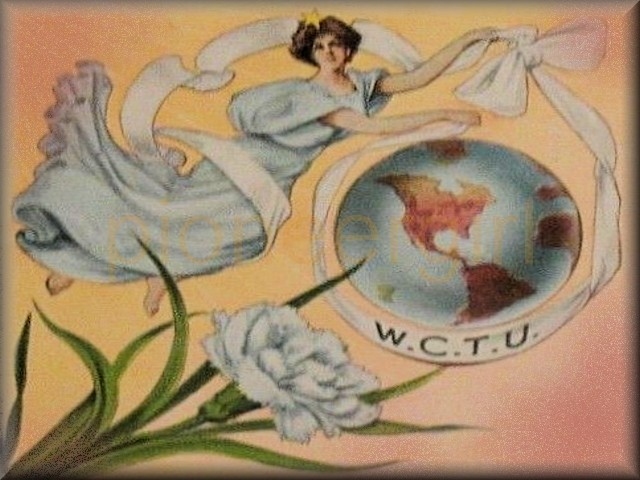Women’s Christian Temperance Union

An organization of Christian women banded together for the protection of the home, the abolition of the liquor traffic, and the triumph of Christ’s Golden Rule in custom and in law.
temperance – Habitual moderation in regard to the indulgence of the natural appetites and passions; restrained or moderate indulgence; moderation; as, temperance in eating and drinking; temperance in the indulgence of joy or mirth.
 We believe the maxim of the temperance people – a school house on every hill and no saloon in the valley. – Lake Preston Times, March 1883
We believe the maxim of the temperance people – a school house on every hill and no saloon in the valley. – Lake Preston Times, March 1883
 The Women’s Christian Temperance Union (W.C.T.U.) was a lineal descendant of the great Women’s Temperance Crusade of 1873-1874. It was organized in Cleveland, Ohio, in 1874. For many years, women had been using prayer vigils, persuasion, picketing, and hymn singing to shame men who drank and to persuade saloon owners to close. At a time when men were typically the sole means of support for a family, those same men were consuming about three times the average amount of alcohol consumed today (it was often considered safer to drink alcohol than water, which was often contaminated), and production – and behavior – of local men was suffering because of it.
The Women’s Christian Temperance Union (W.C.T.U.) was a lineal descendant of the great Women’s Temperance Crusade of 1873-1874. It was organized in Cleveland, Ohio, in 1874. For many years, women had been using prayer vigils, persuasion, picketing, and hymn singing to shame men who drank and to persuade saloon owners to close. At a time when men were typically the sole means of support for a family, those same men were consuming about three times the average amount of alcohol consumed today (it was often considered safer to drink alcohol than water, which was often contaminated), and production – and behavior – of local men was suffering because of it.
In De Smet, the first business establishment was Henry Hinz’s saloon, and temperance women immediately took a stand. Laura Ingalls Wilder made it clear what her family thought about drinking in Little Town on the Prairie (see Chapter 6, “The Month of Roses”). Pa states that two saloons in town are two saloons too many, and Ma replies that “women must bestir themselves and have something to say about it.” The temperance movement had been strong in Walnut Grove, so it was not new to the Ingallses. In December 1881, forty temperance men near Lake Henry called for the organization of societies in Kingsbury County, and Visscher Barnes and John Anderson had spread the word to De Smet, with a mass convention held at the Congregational Church on February 22, 1882. Reverend Brown, Reverend Horace Woodworth, Visscher Barnes, Arthur Sherwood, Timothy Johnson, and Daniel Loftus were among the organizers.
The W.C.T.U. was organized at the same time, with quarterly meetings first held at the Congregational Church, then rotated among the local churches as more sanctuaries were built. Mrs. Maria Owen (wife of John A. Owen) was president until her death in 1888. Laura Brown (wife of Rev. Brown) was recording secretary. In Pioneer Girl, Laura Ingalls Wilder wrote that she attended the organizational meeting with her mother, but refused “for no good reason” to join, except that she had a distaste for everyone at the meeting except Ma. In Dakota Territory, attorney Cynthia Cleveland of Pierre, distant cousin of Grover Cleveland, had been appointed president of the W.C.T.U. in the Dakotas, and she came to De Smet to speak about temperance matters on more than one occasion. It is not known if any of the Ingallses attended these talks.
In 1895, Carrie Ingalls was secretary of the W.C.T.U. An interesting ordinance was submitted by the group that year and voted on in De Smet; the women wanted the front curtains removed from the saloon so that all who walked by could see who was inside!
The pin in Charles’ arm. In March 1883, the women urges that “the nature of alcohol, and its effects upon the human organism, be taught in [the] public schools.” [Iroquois Herald, March 9, 1883] To this end, all teachers in the county were required to spend ten minutes twice weekly teaching from Julia Colman’s book, Alcohol and Hygiene, the W.C.T.U giving a copy of Colman’s book to each teacher in Kingsbury County. It’s a small volume, 231 pages, first published in 1880.
While the intention was to teach the evils of drink, at the beginning it reads like an instruction manual for the home brewer. There are even simple science experiments to learn how beer, wine, and cider are made. These are followed by more complex chemistry experiments in distillation and fermentation. About fifty pages in, it’s time to get serious. Alcohol is poison, so there are lessons about alcohol and the nerves, alcohol and the stomach, alcohol and the liver. It’s all disease, insantity, and death.
Lesson IX is “Alcohol and the Nerves.” It begins by telling you that the body is seven-eighths water, then that blood has almost four times as much water as solid matter. Colman says: “And the body is so full of blood that you can not put in the point of the finest needle anywhere but that it will find some. You can try that for an experiment if you like.”
From These Happy Golden Years, Chapter 3, “One Week” — [Laura] turned her eyes from the window and saw Charles half-asleep. Suddenly he jumped wide awake. Clarence had jabbed his arm with a pin.
“Look, Miss Ingalls! Miss Colman was right! Charles is bleeding.”

Women’s Christian Temperance Union (W.C.T.U.) – (PG)
W.C.T.U. (PG)

